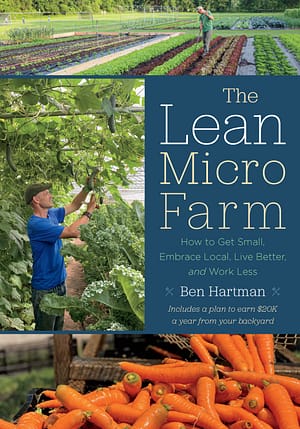Starting A Micro-Farm: Tips for Getting Smaller

Want to set up your own micro-farm? These tips will help you learn how to simplify your work, increase profitability, and shape your ideas so you can create the perfect tiny farm for you.
The following is an excerpt from The Lean Micro Farm by Ben Hartman. It has been adapted for the web.
Unless otherwise noted, all photographs and illustrations copyright © 2023 by Clay Bottom Farm. Featured photo courtesy of Adam Derstine.
Setting Up A Micro-Farm
As we discussed my travels, Rachel and I chose five principles to guide us as we set up our new micro farm:
- Leverage constraints.
- Build just enough (then maximize fixed costs).
- Essentialize.
- Simplify fieldwork.
- Localize.
These principles help balance the life we want with the work that we are doing. They allow us to farm and live better.
Starting A Micro-Farm With 5 Principles
These are principles that we try to follow even today, though we are a long way from mastering them. The impulse and incentives to get bigger, do more, and sell food farther away from home are around us all the time. The default mode in our economy is constant growth.
Our five principles are like anchors: they ground our decisions against the lure of getting bigger.
More specifically, here is how these ideas shaped our tiny farm.
1. Leverage Constraints
Carefully set limits of size, time, and business shape at the outset.
We started by evaluating the scale of farm we wanted, given our new reality of farming with kids. How many hours did we want to devote to the business? How many acres did we need to farm in order to meet our financial goals? How far away should we deliver our food?
Carefully chosen boundaries helped us keep our focus during our 12 months of construction, and they continue to guide us even now.
2. Build Just Enough (Then Maximize Fixed Costs)
Use the right amount of infrastructure: not too much, not too little.
We worked hard to build a just enough farm, where every bit of infrastructure would be well used. We designed our farm taking cues from efficient and small-scale preindustrial farmstead models that relied on multipurpose spaces and creative farm layouts that made the most of every square foot.
3. Essentialize Your Micro-Farm
Focus on the most vital crops and accounts.
The next task was to edit, or to separate the vital few from the trivial many, as Vilfredo Pareto, an Italian economist, once put it. According to Pareto, roughly 80 percent of outcomes stem from 20 percent of causes (the “vital few”).
Thus, about 20 percent of our time, energy, and effort was likely producing 80 percent of our profits. We used this concept to carefully choose five focus crops and a small handful of accounts that order on a consistent basis.
We can count on fairly predictable weekly orders from our grocery and restaurant accounts. This tight focus is a key reason behind our financial stability, and it allows a workload that feels balanced, with enough time for family outside of farming.
4. Simplify Fieldwork
Farm with the simplest approach possible, with just a few tools.
Next, we set out to simplify our work. Could we farm with fewer tools? Could we prepare growing beds with fewer steps? Could we farm with less digging, less gas, less fertilizer, and less plastic? Could we wash lettuce with less water? Every process could be simplified. It was just a matter of discovering how.
5. Localize
Put the community at the center of the farm.
In The Lean Farm, I wrote about genchi gembutsu, the Japanese product-design practice of listening deeply to customers to thoroughly understand them and what they are willing to pay for.
At our new farm, we wanted to add another concept: Gandhi’s “spirit of Swadeshi,” or self-reliance at the village level. How might we design a farm that is deeply woven into the local community?
Recommended Reads
Two-Step Bed Flipping: Increasing Your Production on a Small Footprint
Recent Articles
Oxeye daisies are one of the most important plants for pollinators including beetles, ants, and moths that use oxeye daisies as a source of pollen and nectar. Instead of thinking about removing a plant like oxeye daisy, consider how you can improve the fertility and diversity of habitat resources in your home landscape, garden, or…
Read MoreSo you want to start reaping your harvest, but you’re not sure where to start? Learn how to break down the options of harvesting tools!
Read MoreWhat’s so great about oyster mushrooms? First, you can add them to the list of foods that can be grown indoors! They are tasty, easy to grow, multiply fast, and they love a variety of substrates, making oyster mushrooms the premium choice. The following is an excerpt from Fresh Food from Small Spaces by R. J.…
Read MoreEver heard the phrase, “always follow your nose?” As it turns out, this is a good rule of thumb when it comes to chicken manure. Composting chicken manure in deep litter helps build better chicken health, reduce labor, and retain most of the nutrients for your garden. The following is an excerpt from The Small-Scale Poultry…
Read More









